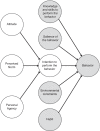Developing a design-based concept to improve hand hygiene in the neonatal intensive care unit
- PMID: 36694024
- PMCID: PMC10382316
- DOI: 10.1038/s41390-023-02482-9
Developing a design-based concept to improve hand hygiene in the neonatal intensive care unit
Abstract
Background: Hand hygiene (HH) is the most critical measure in the prevention of nosocomial infections in the neonatal intensive care unit (NICU). Improving and sustaining adequate HH compliance rates, however, remains a significant challenge. Using a behavioral change framework and nudge theory, we developed a design-based concept aimed at facilitating and stimulating HH behavior.
Methods: Concept development was initiated by selecting a theoretical framework after which contextual field studies aimed at discovering causes for poor compliance were conducted. Potential solutions were brainstormed upon during focus group sessions. Low-fidelity prototypes were tested regarding feasibility, usability, and acceptability. A final concept was crafted drawing from findings from each design phase.
Results: Complying with recommended HH guidelines is unrealistic and infeasible due to frequent competing (clinical) priorities requiring HH. The concept "Island-based nursing," where a patient room is divided into two geographical areas, namely, the island and general zone, was created. HH must be performed upon entering and exiting the island zone, and after exposure to any surface within the general zone. Reminding of HH is prompted by illuminated demarcation of the island zone, serving as the concept's nudge.
Conclusions: Island zone demarcation facilitates and economizes HH indications in an innovative and intuitive manner.
Impact: Although hand hygiene (HH) is the single most important element in the prevention of nosocomial infections in neonates, improving and sustaining adequate HH compliance rates remains a significant challenge. Complying with recommended HH guidelines was found to be unrealistic and infeasible due to the significant amount of time required for HH in a setting with a high workload and many competing (clinical) priorities. The concept of "Island-based nursing," under which the primary HH indication is upon entering and exiting the island zone, facilitates and economizes HH indications in an innovative and user-friendly manner.
© 2023. The Author(s).
Conflict of interest statement
The authors declare no competing interests.
Figures




Similar articles
-
Impact of an educational intervention on hand hygiene compliance and infection rate in a developing country neonatal intensive care unit.Int J Nurs Pract. 2015 Oct;21(5):486-92. doi: 10.1111/ijn.12283. Epub 2014 Mar 26. Int J Nurs Pract. 2015. PMID: 24666764
-
A Quality Improvement Initiative to Increase Hand Hygiene Awareness and Compliance in a Neonatal Intensive Care Unit in Haiti.J Trop Pediatr. 2021 Jul 2;67(3):fmaa029. doi: 10.1093/tropej/fmaa029. J Trop Pediatr. 2021. PMID: 32594158
-
The effect of hand hygiene compliance on hospital-acquired infections in an ICU setting in a Kuwaiti teaching hospital.J Infect Public Health. 2013 Feb;6(1):27-34. doi: 10.1016/j.jiph.2012.09.014. Epub 2012 Nov 24. J Infect Public Health. 2013. PMID: 23290090
-
Use of an alcohol-based hand rub and quality improvement interventions to improve hand hygiene in a Russian neonatal intensive care unit.Infect Control Hosp Epidemiol. 2003 Mar;24(3):172-9. doi: 10.1086/502186. Infect Control Hosp Epidemiol. 2003. PMID: 12683507 Clinical Trial.
-
Barriers to hand hygiene practices among health care workers in sub-Saharan African countries: A narrative review.Am J Infect Control. 2019 May;47(5):565-573. doi: 10.1016/j.ajic.2018.09.014. Epub 2018 Nov 20. Am J Infect Control. 2019. PMID: 30470526 Review.
Cited by
-
Perceptions of distinctions between patient and healthcare zones among intensive care unit nurses at a Korean tertiary hospital: A cross-sectional study.PLoS One. 2024 Nov 15;19(11):e0311298. doi: 10.1371/journal.pone.0311298. eCollection 2024. PLoS One. 2024. PMID: 39546462 Free PMC article.
References
-
- Helder OK, et al. The impact of an education program on hand hygiene compliance and nosocomial infection incidence in an urban neonatal intensive care unit: an intervention study with before and after comparison. Int. J. Nurs. Stud. 2010;47:1245–1252. doi: 10.1016/j.ijnurstu.2010.03.005. - DOI - PubMed
MeSH terms
LinkOut - more resources
Full Text Sources
Medical

